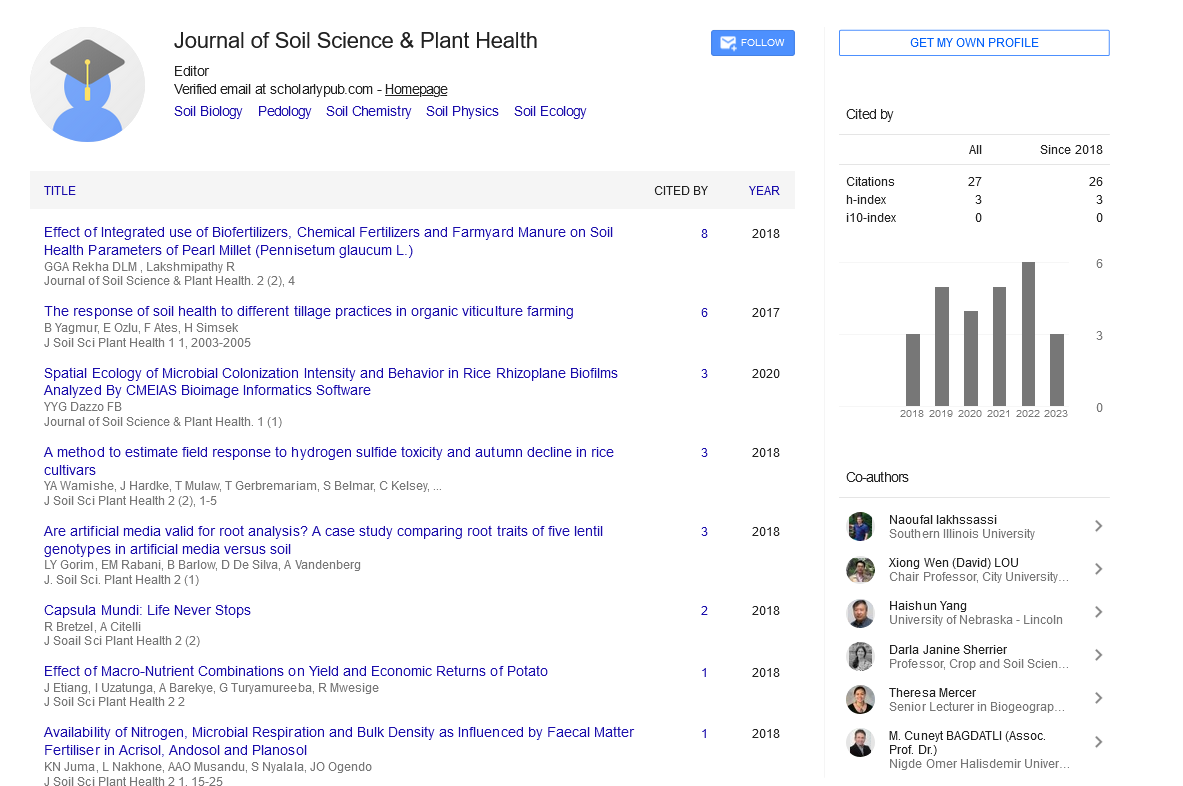Commentary, J Soil Sci Plant Health Vol: 8 Issue: 1
Soil Health Assessment and Monitoring for Sustainable Agriculture
Yeon Lee*
Department of Environmental and Agricultural Chemistry, Gyeongsang National University, 501 Jinju-daero, Jinju-si, Gyeongsangnam-do, South Korea
- *Corresponding Author:
- Yeon Lee
Department of Environmental and Agricultural Chemistry,
Gyeongsang National University,
501 Jinju-daero,
Jinju-si,
Gyeongsangnam-do,
South Korea
E-mail: yeonlee123@gmail.com
Received date: 27 October, 2023, Manuscript No. JSPH-23-118486;
Editor assigned date: 30 October, 2023, PreQC No. JSPH-23-118486 (PQ);
Reviewed date: 13 November, 2023, QC No. JSPH-23-118486;
Revised date: 05 January, 2024, Manuscript No. JSPH-23-118486 (R);
Published date: 12 January, 2024, DOI: 10.4172/jsph.1000222
Citation: Lee Y (2024) Soil Health Assessment and Monitoring for Sustainable Agriculture. J Soil Sci Plant Health J 8:1.
Description
Soil health is a critical component of sustainable agriculture. Healthy soil not only supports robust crop growth but also contributes to environmental sustainability and resilience against climate change. Assessing and monitoring soil health are essential practices for farmers and land managers, as they provide insights into the soil's ability to provide nutrients, support biodiversity, and mitigate environmental impacts. The importance of soil health assessment and monitoring in the context of sustainable agriculture. To ensure longterm agricultural sustainability and productivity, it is imperative to assess and monitor soil health. This manuscript delves into the importance of soil health assessment, the key parameters involved, and the role of monitoring in promoting sustainable agriculture.
Soil health refers to the overall condition of the soil in a given area, encompassing its physical, chemical, and biological attributes. A healthy soil exhibits several key characteristics:
Healthy soil is well-structured, with a balance of solid particles, water, and air, promoting root growth and water infiltration.
It contains an ample supply of essential nutrients for plant growth, while also ensuring their availability to plants.
A thriving soil ecosystem, including beneficial microorganisms and earthworms, contributes to organic matter decomposition and nutrient cycling.
Healthy soil can withstand environmental stresses, such as drought and extreme weather events, without significant degradation.
Soil health assessment helps in determining the right amount of nutrients required for crops, reducing overuse of fertilizers, which can harm the environment.
Healthy soil can contribute to natural disease and pest suppression, reducing the need for chemical interventions.
Knowledge of soil health aids in efficient water management, reducing water runoff and conserving resources.
Understanding soil health allows for informed crop selection, matching the plant's requirements with the soil's capabilities.
Healthy soil supports biodiversity and reduces soil erosion and nutrient runoff, promoting overall environmental health.
Several methods are used for soil health assessment: This includes measuring soil texture, structure, and porosity. Techniques like soil texture analysis and soil compaction testing can provide valuable insights.
Soil pH, nutrient content, and cation exchange capacity are essential chemical properties to assess. Soil testing is commonly used to measure these attributes.
Assessing the biological aspects of soil health involves examining the microbial community, earthworm activity, and soil respiration rates.
Crop growth and development can serve as an indirect indicator of soil health. Monitoring crop yields and quality over time provides insights.
Long-term soil health monitoring is critical for sustainable agriculture: Trends in soil health over time help in identifying areas of improvement or potential issues.
Continuous monitoring enables farmers and land managers to make timely adjustments to their practices.
Data gathered from long-term monitoring contribute to the development of sustainable land management plans.
A well-monitored and managed soil system is better prepared to withstand environmental challenges, including climate change.
Soil health assessment and monitoring are not without challenges: Some assessment methods can be expensive and require specialized equipment.
Understanding and interpreting soil health data can be complex, requiring expertise.
The development of standardized protocols for soil health assessment is an ongoing process.
Effective knowledge transfer and adoption of sustainable soil management practices are essential.
Conclusion
Soil health assessment and monitoring are integral components of sustainable agriculture. Healthy soils not only support crop growth but also contribute to environmental conservation and resilience. The knowledge gained from assessing and monitoring soil health helps farmers and land managers make informed decisions, optimize resource use, and ensure long-term sustainability. As agriculture faces evolving challenges, maintaining and improving soil health remains a fundamental aspect of responsible land management and global food security. By routinely assessing and monitoring soil health, farmers and land managers can make informed decisions to optimize soil conditions, increase crop yields, and contribute to a more sustainable and resilient agricultural future. In a world facing growing food demands and environmental challenges, preserving and enhancing soil health is more critical than ever.
 Spanish
Spanish  Chinese
Chinese  Russian
Russian  German
German  French
French  Japanese
Japanese  Portuguese
Portuguese  Hindi
Hindi 